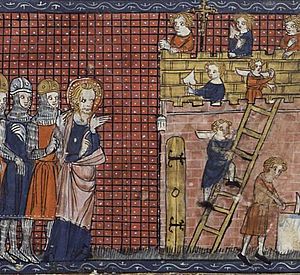Saint Valentine facts for kids
Quick facts for kids SaintValentine |
|
|---|---|
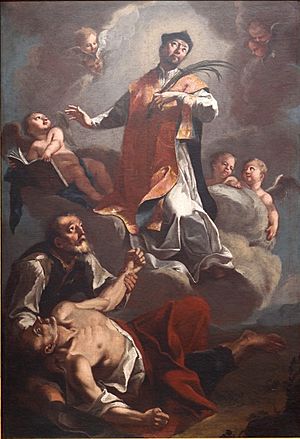
The Triumph of Saint Valentine painted by Valentin Metzinger, early 18th century
|
|
| Bishop and Martyr | |
| Born | c. 226 Terni, Italia, Roman Empire |
| Died | c. 269 (aged 42–43) Rome, Roman Empire |
| Venerated in | Catholic Church Anglican Communion Eastern Orthodoxy Lutheranism |
| Feast | February 14 (Catholic, Anglican and Lutheran Churches), July 6 and July 30 (Eastern Orthodox) |
| Attributes | Birds; roses; bishop with a crippled person or a child with epilepsy at his feet; bishop with a rooster nearby; bishop refusing to adore an idol; bishop being beheaded; priest bearing a sword; priest holding a sun; priest giving sight to a blind girl |
| Patronage | Affianced couples, against fainting, beekeepers, happy marriages, love, mentally ill, plague, epilepsy, Lesvos (for Catholics) |
Saint Valentine (Italian: San Valentino; Latin: Valentinus) was a Roman saint who lived in the 3rd century. People in Western Christianity remember him on February 14. In the Eastern Orthodox Church, he is honored on July 6. For a long time, his special day, Valentine's Day, has been linked to love. He is also known as a patron saint for the city of Terni, for people with epilepsy, and for beekeepers.
Saint Valentine was a church leader, either a priest or a bishop. He helped Christians who were being persecuted in the Roman Empire. He was killed for his faith and buried on the Via Flaminia road on February 14. This day has been celebrated as Saint Valentine's Day since at least the 8th century.
Some of his remains were kept in the Catacombs of San Valentino in Rome. This was an important place for visitors during the Middle Ages. Later, his remains were moved to the church of Santa Prassede. His skull, decorated with flowers, is now shown in the Basilica of Santa Maria in Cosmedin in Rome. Other remains are in Whitefriar Street Carmelite Church in Dublin, Ireland. This church is a popular place for people to visit, especially on Valentine's Day, if they are looking for love.
There were at least two different Saint Valentines mentioned in old church records. Professor Jack B. Oruch says that stories about both Saint Valentine of Rome and Saint Valentine of Terni were found in almost every church and monastery in Europe.
Contents
Who Was Saint Valentine?
Saint Valentine is not in the very first list of Roman martyrs from the year 354. However, he is mentioned in a later list called the Martyrologium Hieronymianum, made between 460 and 544. The celebration of Saint Valentine on February 14 was first started in 496 by Pope Gelasius I. He included Valentine among saints whose "names are justly reverenced among men, but whose acts are known only to God."
The Catholic Encyclopedia and other books about saints talk about three different Saints Valentine linked to February 14.
- One was a Roman priest.
- Another was a bishop from Interamna (now Terni, Italy). Both were buried along the Via Flaminia outside Rome.
- The third was said to be a saint who died on the same day in the Roman province of Africa. Not much else is known about this person.
Even though the stories about the first two saints were written much later and have some legendary parts, they might be about the same person. The official story from the Diocese of Terni says that Bishop Valentine was born and lived in Interamna. While visiting Rome, he was arrested, tortured, and killed there on February 14, 269. His body was quickly buried, but a few nights later, his followers took his body back home.
The Roman Martyrology, which is the Catholic Church's official list of saints, mentions only one Saint Valentine for February 14. He is described as a martyr who died on the Via Flaminia.
The name "Valentine" comes from the Latin word valens, meaning "worthy, strong, powerful." This name was popular in ancient times. About eleven other saints named Valentine are honored in the Catholic Church on different days.
Stories and Legends
The stories about Saint Valentine are not always the same. A common story says Saint Valentine was a priest in Rome or a bishop from Terni, a town in central Italy.
One legend tells that Valentine was under house arrest by a judge named Asterius. Valentine and the judge talked about faith. The judge tested Valentine by bringing his adopted blind daughter to him. The judge said if Valentine could make the girl see again, he would do whatever Valentine asked. Valentine prayed to God and placed his hands on her eyes. The girl's vision was restored!
The judge was amazed and asked Valentine what he should do. Valentine told him to break all the idols in his house, fast for three days, and then be baptized as a Christian. The judge followed these instructions. Because of his fasting and prayers, he freed all the Christian prisoners he was holding. The judge, his family, and 44 other people in his household were all baptized.
Valentine was later arrested again for continuing to share his faith. He was sent to the Roman prefect and then to Emperor Claudius Gothicus (Claudius II) himself. Claudius liked Valentine at first, until Valentine tried to convince him to become a Christian. Claudius refused and ordered Valentine to be killed. He said Valentine must give up his faith or be beaten and beheaded. Valentine refused and was executed outside the Flaminian Gate on February 14, 269.
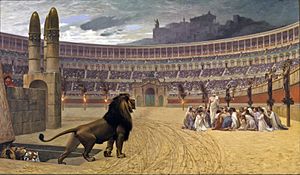
An added detail to this story says that before he was executed, Saint Valentine wrote a note to Asterius's daughter. He signed it "from your Valentine." This is thought to be the reason we sign romantic messages with "from your Valentine" today.
Another popular legend says that in the 3rd century AD, Valentine, who was a priest, went against Emperor Claudius's orders. Claudius had forbidden soldiers from marrying. Valentine secretly performed Christian weddings for couples. This allowed the husbands to avoid being forced into the pagan army. It is said that Valentine cut out hearts from parchment to remind these men of their promises and God's love. This might be why hearts are so common on Valentine's Day.
Churches Named After Saint Valentine
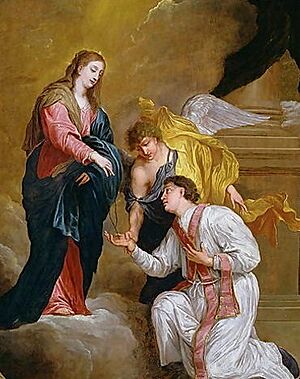
Many churches are named after Saint Valentine, especially in Italy. Saint Valentine was honored like other Christian martyrs and saints.
An old writing from the 5th or 6th century tells a story about a basilica (a type of church) in Rome being named after Saint Valentine. A later story added that Pope Julius I (who lived from 357 to 352 AD) built the ancient basilica S. Valentini extra Portam over Valentine's burial place. This church was actually named after a 4th-century official named Valentino, who gave the land for it. It held the saint's remains until the 13th century, when they were moved to Santa Prassede. The old basilica then fell into disrepair.
A modern church called Saint Valentine's Church was built in Rome in 1960. It was built for the people living in the Olympic Village and is still a popular church today.
Saint Valentine's Day
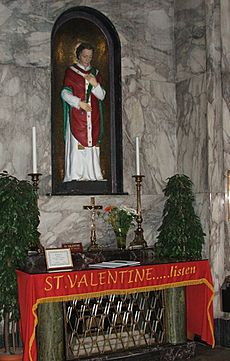
Saint Valentine of Rome was killed for his faith on February 14 in AD 269. The Feast of Saint Valentine, also known as Saint Valentine's Day, was started by Pope Gelasius I in AD 496. It was created to honor the Christian martyr.
February 14 is Saint Valentine's Day in the Lutheran calendar of saints. Valentine is remembered in the Church of England on February 14. The Catholic Church still includes him in its official list of saints, the Roman Martyrology.
In the Eastern Orthodox Church, they celebrate the Roman priest Valentine on July 6. They also honor Hieromartyr Valentine, Bishop of Interamna, on July 30.
In the 18th century, some historians like Alban Butler and Francis Douce thought that Saint Valentine's Day was created to replace an old pagan holiday called Lupercalia. This holiday was celebrated in Rome in mid-February. However, many modern experts, like Jack B. Oruch and Henry Ansgar Kelly, have shown that this idea is not true.
Many of the stories we know about Saint Valentine today were made up in England in the 14th century. This was especially true by Geoffrey Chaucer and his friends. This is when the feast day of February 14 first became linked to romantic love.
Oruch argues that the traditions we connect with "Valentine's Day" did not exist before Chaucer wrote about them. He says that the idea of these customs being very old came from historians in the 18th century.
During the Middle Ages, people believed that birds found their mates in mid-February. This idea then became linked to the romance of Valentine. Even though the legends are different, Valentine's Day is widely known as a day for romance and showing love.
Relics of Saint Valentine
The skull of Saint Valentine, decorated with flowers, is shown in the Basilica of Santa Maria in Cosmedin in Rome.
Some of Saint Valentine's remains are kept in St Anton's Church in Madrid, Spain. They have been there since the late 1700s. They were a gift from the Pope to King Carlos IV. These remains have been shown to the public since 1984.
Whitefriar Street Carmelite Church in Dublin, Ireland, also has some remains of Saint Valentine. In 1835, parts of Saint Valentine's remains were sent to the Carmelite order in Dublin by Cardinal Carlo Odescalchi, with permission from Pope Gregory XVI. These remains, which include "a small vessel tinged with his blood," have been in the church ever since. They were sent as a sign of respect after a sermon given by Father John Spratt in Rome.
On Saint Valentine's Day in Ireland, many people looking for true love visit the Shrine of St. Valentine in Whitefriar Street Carmelite Church in Dublin. They pray at the shrine hoping to find romance. There is a book where people from all over the world have written their prayers for love.
Another relic was found in 2003 in Prague in the Basilica of St. Peter and St. Paul at Vyšehrad.
A silver container holding a piece of St. Valentine's skull is in the church of St. Mary's Assumption in Chełmno, Poland.
Other remains can also be found in Mytilene on the Greek island of Lesbos. Another set of remains is in Savona, Italy, in the Cathedral of Santa Maria Assunta.
Alleged remains of St. Valentine are also in Roquemaure, Gard, France, in the St. Stephen's Cathedral, Vienna, in Balzan in Malta, and in Blessed John Duns Scotus Church in Glasgow, Scotland. There is also a gold container with the words "Corpus St. Valentin, M" (Body of St. Valentine, Martyr) at Birmingham Oratory, UK.
See also
 In Spanish: Valentín de Roma para niños
In Spanish: Valentín de Roma para niños
- La Fête du Baiser
- Persecution of Christians in the Roman Empire
- Saint Fructus, 8th-century Spanish martyr
- Saint Valentine, patron saint archive
- Saint Valentine's Key


